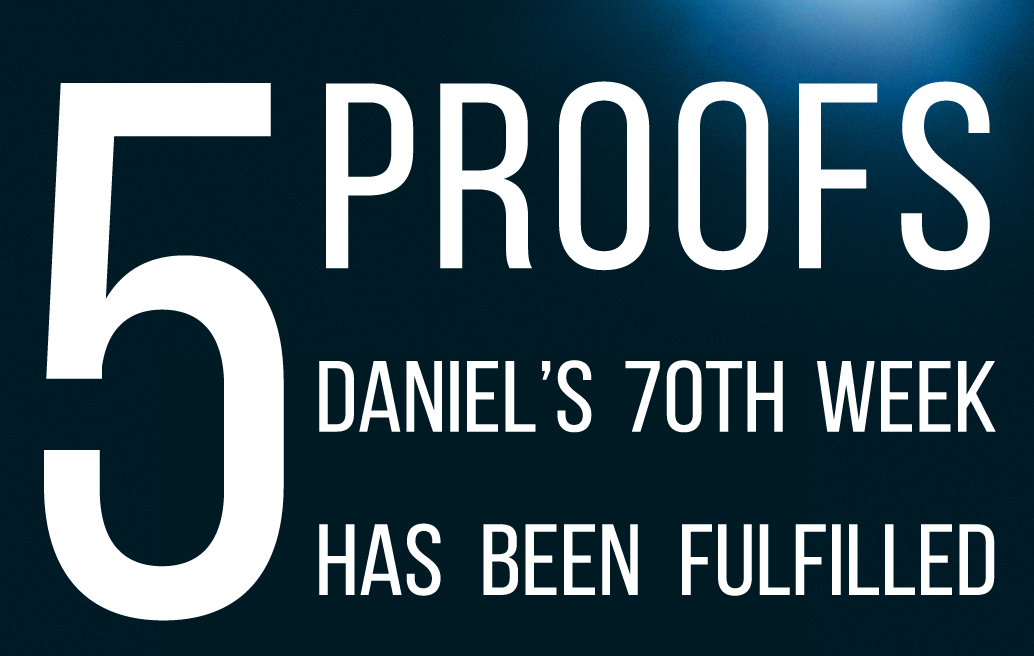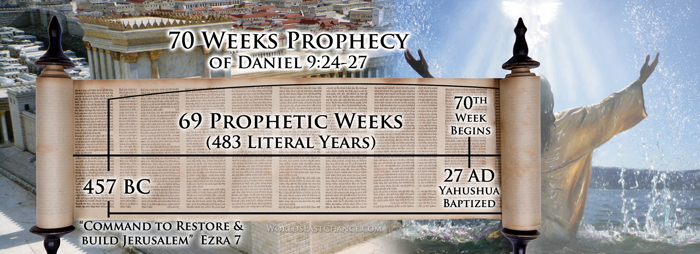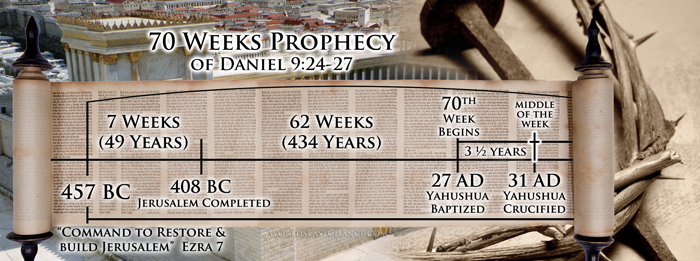
“24Seventy weeks are determined for your people and for your holy city, to finish the transgression, to make an end of sins, to make reconciliation for iniquity, to bring in everlasting righteousness, to seal up vision and prophecy, and to anoint the Most Holy. 25Know therefore and understand, that from the going forth of the command to restore and build Jerusalem until Messiah the Prince, there shall be seven weeks and sixty-two weeks; the street shall be built again, and the wall, even in troublesome times. 26And after the sixty-two weeks Messiah shall be cut off, but not for Himself; And the people of the prince who is to come shall destroy the city and the sanctuary. The end of it shall be with a flood, And till the end of the war desolations are determined. 27Then He shall confirm a covenant with many for one week; But in the middle of the week He shall bring an end to sacrifice and offering. And on the wing of abominations shall be one who makes desolate, even until the consummation, which is determined, is poured out on the desolate.” (Daniel 9:24-27, NKJV)
Daniel’s “seventy weeks” prophecy was fulfilled in the first century. Sadly, though, many today have failed to recognize this wonderful truth and insist that the final week of Daniel’s prophecy has not yet been fulfilled.

There is absolutely nothing in the text that suggests that the “seventy weeks” are to be split up.
|
1. Counting logically: There is absolutely nothing in the text that suggests that the “seventy weeks” are to be split up. The angel, Gabriel, nowhere even hints at a two-thousand-year intermission between the 69th week and the 70th week. Insisting on such a gap is adding to Scripture and negates the very point of the prophecy. Gabriel was giving Daniel a clear timeline of events leading up to the coming of the Messiah and the subsequent destruction of earthly Jerusalem. This was in answer to Daniel’s lamentation over the sins of his people and the current state of the city (Dan. 9:1-19). Gabriel, while noting the ultimate fate of rebellious earthly Jerusalem, was giving Daniel hope; the angel was pointing Daniel to the coming of the promised Messiah – the hope of Israel.
Daniel 9:25 tells us that “from the going forth of the command to restore and build Jerusalem until Messiah the Prince, there shall be seven weeks and sixty-two weeks.” Thus, a total of 69 prophetic weeks was to stretch from the command to restore Jerusalem until the coming of the Messiah. This is equivalent to 483 literal years (69 prophetic weeks = 483 prophetic days = 483 literal years1). The decree to rebuild Jerusalem was given by Artaxerxes in 457 BC2, which places the coming of the Messiah in 27 AD. This is readily recognized by most Bible students, as it is generally accepted that Yahushua was anointed with the Holy Spirit at his baptism in 27 AD.3

It’s from the point forward, though, that there has been much confusion. Futurists posit that the remaining events of the prophesy are still awaiting fulfillment. The fallacy of this suggestion is demonstrated below. All of the events prophesied to take place in the seventieth week have already transpired:
Those who insist on separating the 70th week from the rest of the prophecy are inadvertently denying the crucifixion of our lord, Messiah Yahushua.
|
2. Messiah’s Crucifixion: Verse 26 prophesied that the Messiah was to “be cut off, but not for himself4.” Yahushua was cut off (crucified) in the Spring of 31 AD, 3 ½ years after his baptism (27 AD) – in the middle of the 70th prophetic week. (Brenton’s translation of the Septuagint renders this phrase as, “the anointed one shall be destroyed.” Dan. 9:26) This is a very serious problem for the futurist because they place the final week of Daniel’s prophecy in the future. If the final week of Daniel’s prophecy is still future, then the Messiah has not yet been “cut off” for our sins. Even if one is contentious about the specific years of Yahushua’s baptism and crucifixion, the problem remains unsurmountable for the honest Bible student. The 69 prophetic weeks carried us forward to the time of Yahushua’s anointing (baptism); that being the case, his being “cut off” had to take place in the middle of the 70th prophetic week. Those who insist on separating the 70th week from the rest of the prophecy are inadvertently denying the crucifixion of our lord, Messiah Yahushua.

To insist that Daniel’s 70th week has not yet been fulfilled is to disaffirm the great prophetic judgment upon earthly Jerusalem – a judgment that Yahushua warned about throughout his earthly ministry.
|
3. Sanctuary Destroyed: In verse 26, we are told that “the people of the prince who is to come shall destroy the city and the sanctuary.” As Heaven's final confirmation that the 70 prophetic weeks allotted for the Jewish nation and earthly Jerusalem had been fulfilled, the city and the temple were destroyed in 70 AD. This is history. The destruction of the earthly sanctuary happened right on time, in perfect agreement with Gabriel’s timeline. To insist that Daniel’s 70th week has not yet been fulfilled is to disaffirm the great prophetic judgment upon earthly Jerusalem – a judgment that Yahushua warned about throughout his earthly ministry.
Note: "The people of the prince that shall come" in verse 26 denotes that Rome was carrying out Heaven's judgment in destroying the earthly city and temple. "The end of it shall be with a flood" denotes the swiftness with which the judgment fell. "And till the end of the war desolations are determined": (1) foretold the swift destruction of Jerusalem, which was fulfilled in 70 AD; (2) foretells the fact that from the time of the destruction of the temple until the End of time, the land occupied by ancient Israel will never see peace and stability. This is confirmed today by the endless wars between Israel and its neighbors. This desolation is also alluded to in Daniel 9:27.
[T]here is absolutely no mention of an antichrist anywhere in the text.
|
4. Confirming the New Covenant: Verse 27 tells us that “he [Messiah] shall confirm a covenant with many for one week.” Yahushua, the Messiah, confirmed the New Covenant throughout his 3 ½ year ministry and ultimately sealed it with his own blood when he was crucified in the middle of the 70th prophetic week. Following Yahushua’s death, the apostles continued to proclaim the New Covenant for 3 ½ more years. The invitation to accept the covenant was extended to the Jewish nation until the autumn of 34 AD, when the Sanhedrin murdered Stephen, the first Christian martyr (Acts 7). Immediately following this final act of rebellion, the gospel went to the gentiles. Thus, the covenant was confirmed for the duration of the 70th prophetic week. Again, this has serious implications for those who teach that the 70th week is still future, as they are unwittingly denying Messiah Yahushua’s establishment of the New Covenant. Not only this, but they say that the “he” in verse 27 is “antichrist” when there is absolutely no mention of an antichrist anywhere in the text. The “he” in verse 27 is clearly a reference to the Messiah of verse 26. Yahuwah forbid that we refer to His anointed as antichrist!

Upon Yahushua’s death, “the veil of the temple was torn in two from top to bottom” by Yahuwah himself – signifying an end to sacrifices.
|
5. The Final Sacrifice: Reading on in verse 27, it says, “But in the middle of the [70th] week He shall bring an end to sacrifice and offering.” Yahushua was crucified in the middle of the 70th prophetic week, bringing an end to sacrifice and offering. It was the promised Messiah who did this, not some future antichrist that is going to storm a rebuilt earthly temple. The author of Hebrews goes through great pains to stress the eternal value of Yahushua’s once and for all sacrifice for sin. It was Yahushua “with his own blood . . . [that] entered the Most Holy Place once for all, having obtained eternal redemption.” (Heb. 9:12) “[W]e have been sanctified through the offering of the body of Messiah Yahushua once for all.” (Heb. 10:10) Upon Yahushua’s death, “the veil of the temple was torn in two from top to bottom” by Yahuwah himself – signifying an end to sacrifices5. To posit that this prophecy pertains to some future antichrist that will enter a rebuilt temple is to degrade the eternal value of Yahushua's atoning sacrifice and to do violence to the text. Such interpretations are founded on sensationalism and imagination, not Biblical exegesis.
For a more in-depth examination of Daniel’s seventy-weeks prophecy:
1 In Scripture, one prophetic day = one literal year. See: Numbers 14:34; Ezekiel 4:6.
2 The accession year of Artaxerxes I was 465-464 BC; his first regnal year stretched from the autumn of 464 BC to the autumn of 463 BC. We know that the "going forth" of Artaxerxes' decree was in 457 BC because Ezra tells us that he departed Babylon in the spring, in the first [Biblical] month, and arrived in Jerusalem in the fifth [Biblical] month of Artaxerxes' seventh year. "And he [Ezra] came to Jerusalem in the fifth month, which was in the seventh year of the king. For upon the first day of the first month began he to go up from Babylon, and on the first day of the fifth month came he to Jerusalem, according to the good hand of his Elohim was upon him." (Ezra 7:8-9)
3 “Seventy weeks are determined for your people and for your holy city, to finish the transgression, to make an end of sins, to make reconciliation for iniquity, to bring in everlasting righteousness, to seal up vision and prophecy, and to anoint the Most Holy.” (Dan. 9:24)
4 He was “cut off, but not for Himself.” (Daniel 9:26) Isaiah 53 contains a remarkable prophesy of Yahushua’s atoning work on our behalf. It was for us that he was “cut off.”
5 See Matthew 27:51.